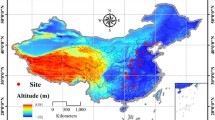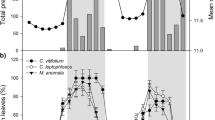Abstract
Plants develop diverse adaptive traits in changeable environments, yet whether plant defense traits change during succession remains unclear. In this study, we investigated the young leaf physical traits (i.e., upright orientation of leaves, trichomes, an enhanced cuticle, and a multilayered epidermis) and leaf color trait (i.e., red pigmentation) of dominant plants in three subtropical forests. These forests included a pioneer forest, a mixed coniferous-broadleaved forest, and a monsoon-evergreen broadleaved forest representing early, middle, and later successional stages, respectively. Our results show that the red color trait in young leaves is related to anti-herbivory defense, and the percentage of species with red young leaves is higher in later than in early succession. Physical defense tends to be weaker for red young leaves than for green young leaves in early and middle successions. In addition, the number of defense traits of young leaves increases with succession. We speculate that young leaves in subtropical forests depend increasingly on multiple defense traits during succession because of the increased biotic stresses and environmental complexity in later succession.




Similar content being viewed by others
References
Agrawal AA (2011) Current trends in the evolutionary ecology of plant defence. Funct Ecol 25:420–432
Agrawal AA, Fishbein M (2006) Plant defense syndromes. Ecology 87:132–149
Archetti M, Döring TF, Hagen SB, Hughes NM, Leather SR, Lee DW, Lev-Yadun S, Manetas Y, Ougham HJ, Schaberg PG, Thomas H (2009) Unravelling the evolution of autumn colours: an interdisciplinary approach. Trends Ecol Evol 24:166–173
Bari R, Jones JD (2009) Role of plant hormones in plant defence responses. Plant Mol Biol 69:473–488
Barton KE, Koricheva J (2010) The ontogeny of plant defense and herbivory: Characterizing general patterns using meta-analysis. Am Nat 175:481–493
Bennett RN, Wallsgrove RM (2006) Secondary metabolites in plant defence mechanisms. New Phytol 127:617–633
Chabot BF, Hicks DJ (1982) The ecology of leaf life spans. Annu Rev Ecol Syst 13:229–259
Chassot C, Nawrath C, Métraux JP (2008) The cuticle: Not only a barrier for plant defence: A novel defence syndrome in plants with cuticular defects. Plant Signal Behav 3:142–144
Chen YZ, Huang SQ (2013) Red young leaves have less mechanical defence than green young leaves. Oikos 122:1035–1041
Coley PD, Barone JA (1996) Herbivory and plant defenses in tropical forests. Annu Rev Ecol Systemat 27:305–335
Dalin P, Björkman C (2003) Adult beetle grazing induces willow trichome defence against subsequent larval feeding. Oecologia 134:112–118
Davidson DW (1993) The effects of herbivory and granivory on terrestrial plant succession. Oikos 68:23–35
Eichenberg D, Purschke O, Ristok C, Wessjohann L, Bruelheide H (2015) Trade-offs between physical and chemical carbon-based leaf defence: of intraspecific variation and trait evolution. J Ecol 103:1667–1679
Erickson AA, Bell SS, Dawes CJ (2004) Does mangrove leaf chemistry help explain crab herbivory patterns? Biotropica 36:333–343
Grotewold E (2006) The genetics and biochemistry of floral pigments. Annu. Rev. Plant Biol 57:761–780
Guo Q (2003) Temporal species richness-biomass relationships along successional gradients. J Veg Sci 14:121–128
Gutschick VP (1999) Biotic and abiotic consequences of differences in leaf structure. New Phytol 143:3–18
Gutterman Y, Chauser-Volfson E (2000) The distribution of the phenolic metabolites barbaloin, aloeresin and aloenin as a peripheral defense strategy in the succulent leaf parts of aloe arborescens. Biochem Syst Ecol 28:825–838
Hakes AS, Cronin JT (2011) Environmental heterogeneity and spatiotemporal variability in plant defense traits. Oikos 120:452–462
Hanley ME, Lamont BB, Fairbanks MM, Rafferty CM (2007) Plant structural traits and their role in anti-herbivore defence. Perspect Plant Ecol 8:157–178
Heil M, Ton J (2008) Long-distance signalling in plant defence. Trends Plant Sci 13:264–272
Herms DA, Mattson WJ (1992) The dilemma of plants: to grow or defend. Q Rev Biol 67:283–335
Iii FSC, Pugnaire F (1993) Evolution of suites of traits in response to environmental stress. Am Nat 142:S78–S92
Kachroo A, Kachroo P (2009) Fatty acid-derived signals in plant defense. Annu Rev Phytopathol 47:153–176
Kirkwood RC (1999) Recent developments in our understanding of the plant cuticle as a barrier to the foliar uptake of pesticides. J Pestic Sci 55:69–77
Kursar TA, Coley PD (1992) Delayed greening in tropical leaves: an antiherbivore defense? Biotropica 24:256–262
Lamont BB, Groom PK, Cowling RM (2002) High leaf mass per area of related species assemblages may reflect low rainfall and carbon isotope discrimination rather than low phosphorus and nitrogen concentrations. Funct Ecol 16:403–412
Landi M, Tattini M, Gould KS (2015) Multiple functional roles of anthocyanins in plant-environment interactions. Environ Exp Bot 119:4–17
Lee DW, Gould KS (2002) Anthocyanins in leaves and other vegetative organs: An introduction. Adv Bot Res 37:1–16
Levin DA (1973) The role of trichomes in plant defense. Q Rev Biol 48:3–15
Liu J, Yan HF, Newmaster SG, Pei N, Ragupathy S, Ge XJ (2015) The use of DNA barcoding as a tool for the conservation biogeography of subtropical forests in China. Divers Distrib 21:188–199
Manetas Y, Drinia A, Petropoulou Y (2002) High contents of anthocyanins in young leaves are correlated with low pools of xanthophyll cycle components and low risk of photoinhibition. Photosynthetica 40:349–354
Manetas Y (2003) The importance of being hairy: The adverse effects of hair removal on stem photosynthesis of verbascum speciosum are due to solar UV-B radiation. New Phytol 158:503–508
Martin JT (2003) Role of cuticle in the defense against plant disease. Annu Rev Phytopathol 2:81–100
Mittler R (2002) Oxidative stress, antioxidants and stress tolerance. Trends Plant Sci 7:405–410
Moles AT, Bonser SP, Poore AG, Wallis IR, Foley WJ (2011) Assessing the evidence for latitudinal gradients in plant defence and herbivory. Funct Ecol 25:380–388
Peng SL (1996) Community dynamics of lower subtropical forests. Science Press, Beijing
Peng SL, Ren H (1998) The energy ecology study in sub-tropical forest ecosystem. China Meteorological Press, Beijing
Pritsch C, Muehlbauer GJ, Bushnell WR, Somers DA, Vance CP (2000) Fungal development and induction of defense response genes during early infection of wheat spikes by fusarium graminearum. Mol Plant Microbe In 13:159–169
Raevel V, Violle C, Munoz F (2012) Mechanisms of ecological succession: Insights from plant functional strategies. Oikos 121:1761–1770
Sangoi L, Gracietti M, Rampazzo C, Bianchetti P (2002) Response of brazilian maize hybrids from different eras to changes in plant density. Field Crop Res 79:39–51
Schaefer HM, Wilkinson DM (2004) Red leaves, insects and coevolution: a red herring? Trends Ecol Evol 19:616–618
Serrano M, Coluccia F, Torres M, L'Haridon F, Métraux JP (2014) The cuticle and plant defense to pathogens. Front Plant Sci 5:274
Tattini M, Landi M, Brunetti C, Giordano C, Remorini D, Gould KS, Guidi L (2014) Epidermal coumaroyl anthocyanins protect sweet basil against excess light stress: multiple consequences of light attenuation. Physiol Plant 152:585–598
Wagner GJ (1991) Secreting glandular trichomes: More than just hairs. Plant Physiol 96:675–679
Woodman RL, Fernandes GW (1991) Differential mechanical defense : herbivory, evapotranspiration, and leaf-hairs. Oikos 60:11–19
Wu F, Yu Y, Sun J, Zhang J, Wang J, Tang G, Wang Y (2016) Characteristics, source apportionment and reactivity of ambient volatile organic compounds at Dinghu mountain in Guangdong Province, China. Sci Total Environ 548:347–359
Zhou G, Guan L, Wei X, Zhang D, Zhang Q, Yan J, Wen D, Liu J, Liu S, Huang Z (2007) Litterfall production along successional and altitudinal gradients of subtropical monsoon evergreen broadleaved forests in Guangdong, China. Plant Ecol 188:77–89
Acknowledgements
This research was supported by the National Natural Science Foundation of China (no. 31570422) and Guangdong Science and Technology Program (no. 2016A030303044). We thank Mr Yiming Fan for field investigation. Thanks are also due to Prof. Bruce Jaffee for English editing and constructive comments and to anonymous reviewers for their valuable comments on an early version of the manuscript.
Author information
Authors and Affiliations
Corresponding author
Additional information
Communicated by Shayne Martin Jacobs.
Publisher's Note
Springer Nature remains neutral with regard to jurisdictional claims in published maps and institutional affiliations.
Appendices
Appendix 1
See Table 3.
Appendix 2
See Table 4.
Appendix 3
See Table 5.
Rights and permissions
About this article
Cite this article
Han, T., Wang, J., Ren, H. et al. Changes in defense traits of young leaves in subtropical forests succession. Plant Ecol 220, 305–320 (2019). https://doi.org/10.1007/s11258-019-00916-1
Received:
Accepted:
Published:
Issue Date:
DOI: https://doi.org/10.1007/s11258-019-00916-1




